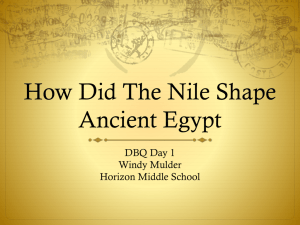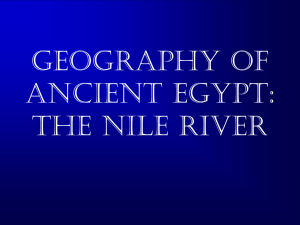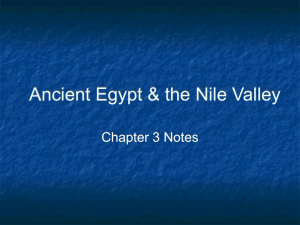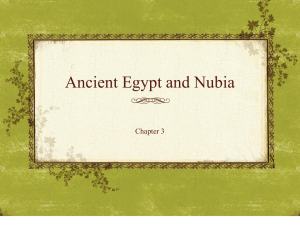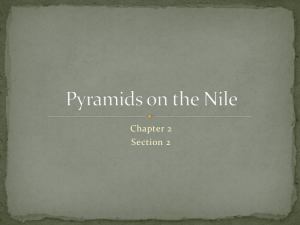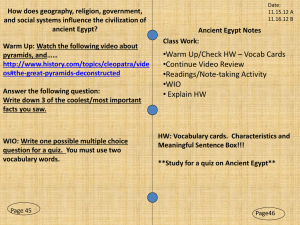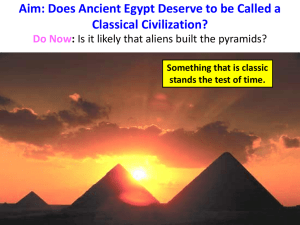Society in the Ancient Eastern Mediterranean 3500 BCE
advertisement
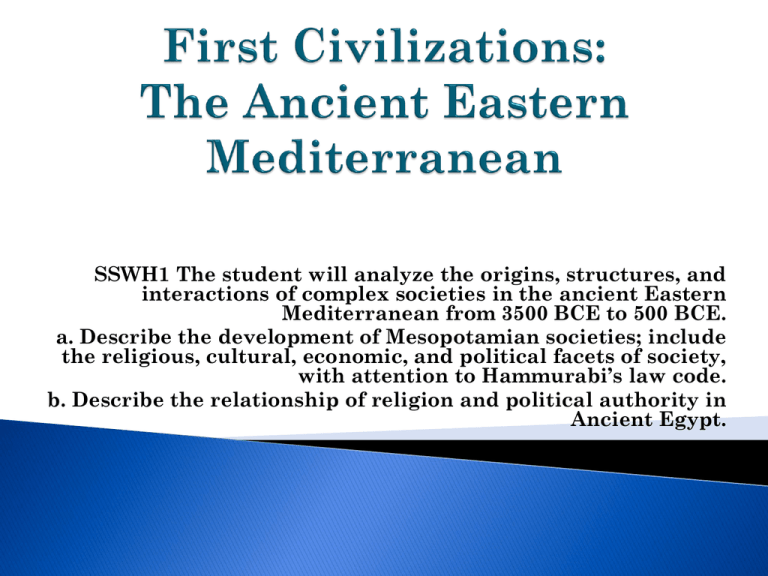
SSWH1 The student will analyze the origins, structures, and interactions of complex societies in the ancient Eastern Mediterranean from 3500 BCE to 500 BCE. a. Describe the development of Mesopotamian societies; include the religious, cultural, economic, and political facets of society, with attention to Hammurabi’s law code. b. Describe the relationship of religion and political authority in Ancient Egypt. Early River Valley Civilizations Environment Sumer Egypt Indus Valley China • Flooding of Tigris and Euphrates unpredictable • No natural barriers • Limited natural resources for making tools or buildings • Flooding of the Nile predictable • Nile an easy transportation link between Egypt’s villages • Deserts were natural barriers • Indus flooding unpredictable • Monsoon winds • Mountains, deserts were natural barriers • Huang He flooding unpredictable • Mountains, deserts natural barriers • Geographically isolated from other ancient civilizations A well-watered and fertile area, the fertile crescent arcs across the northern part of the Syrian desert. It is bordered on the west by the Mediterranean and on the east by the Euphrates and Tigris rivers, and includes all or parts of Israel, the West Bank, Jordan, Lebanon, Syria, and Iraq. From antiquity this region was the site of sophisticated settlements. The valley between the Tigris and Euphrates Rivers was known as Mesopotamia to the ancient Greeks. Means “land between the rivers” At the eastern end of the Fertile Crescent A region with little rain, but rich soil due to flooding in the late spring Irrigation and drainage ditches made it possible to grow crops on a regular basis 3 general areas Assyria, Akkad, and Sumer Created the first Mesopotamian civilization By 3000 BC established a number of independent cities in Southern Mesopotamia including Ur, Uruk and Eridu. As cities expanded they formed city-states, the basic unit of Sumerian civilization. Most prominent building in a Sumerian city was the temple. The temple was often built atop a massive stepped tower called a ziggurat. Believed the gods and goddesses ruled the cities Due to the importance of religion in their government, they were a theocracy- a government by divine authority Eventually the ruling power passed into the hands of worldly figures or kings Believed kings derived their power from the gods Army, government, priests, and priestesses all aided the kings in their rule. Based chiefly on farming The people of Mesopotamia were well known for their metalwork Invention of the wheel led to wheeled carts 3 major social groups: Nobles, commoners, and slaves 90% were farmers (commoners) Slaves belonged to palace officials and were used in building projects By 1792 BC leadership came from Babylon, a city-state south of Akkad, where Hammurabi came to power. He gained control of Sumer and Akkad and created a new Mesopotamian kingdom. Hammurabi is remembered for his law code, a collection of 282 laws. The most complete of ancient law codes Based on a system of strict justice Penalties were severe and varied according to the social class Retaliation – an eye for an eye was a fundamental part of this system The largest category of laws focused on marriage and the family. Marriages were arranged by the parents Without a contract, no one was considered legally married Society was patriarchal- dominated by men; women had far fewer privileges and rights Fathers ruled the children and their wives To the Mesopotamians, powerful spiritual beings – gods and goddesses- permeated all aspects of the universe. Approximately 3000 gods and goddesses Polytheistic- Believed in many gods Humans were inferior to the gods and could never be sure what the gods might do to help or hurt them. The Nile is a unique river, beginning in the heart of Africa and coursing northward for more than 4000 miles. It is the longest river in the world. The Nile Delta is called Lower Egypt; the land upstream, to the south, is called Upper Egypt. To the ancient Egyptians, the most important feature was the yearly flooding. The fertile land the Egyptians called the “Black Land” Blessed by natural barriers, the regularity of the Nile floods created a feeling of security. Religion also provided a sense of security. The ancient Egyptians had no word for religion. Religious ideas were an inseparable part of their world order. Polytheistic- Were divided into two groups sun gods and land gods 3 Major Periods: Old Kingdom, Middle Kingdom, and the New Kingdom These were periods of long term stability The history of Egypt begins around 3100 BCE when Menes united the villages of Upper (southern) and Lower (northern) Egypt into a single kingdom and created the first dynasty. Dynasty - a family of rulers whose right to rule is passed on within the family. Lasted from around 2700 to 2200 BCE Was an age of prosperity and splendor The most common title for Egyptian monarchs was pharaoh meaning “great house” or “palace” Kingship was a divine authority in Ancient Egypt A breakdown in royal power could only mean that citizens were offending the gods and weakening the world order . Lasted from about 2050 to 1652 BCE Egyptians later portrayed the Middle Kingdom as a Golden Age – an age of stability. Egypt began a period of expansion during this period. One feature was a new concern of the pharaohs for the people. He was portrayed as the shepherd who provided for his people. The Middle Kingdom came to an end when the pharaohs were overthrown by a foreign group, the Hyksos A new dynasty used the new weapons and drove out the Hyksos, establishing the New Kingdom in 1567 BCE. The New Kingdom lasted until 1085 BCE. Egypt created an empire and became the most powerful state in Southwest Asia. Massive wealth boosted the power of the New Kingdom Pharaohs God-King (Pharaoh) Upper Class of Nobles and Priests Merchants, Artisans, Scribes, and Tax Collectors (The Middle Class) Peasants – the largest number of people in Egypt simply worked the land Nile River Lower Egypt Upper Egypt Giza
